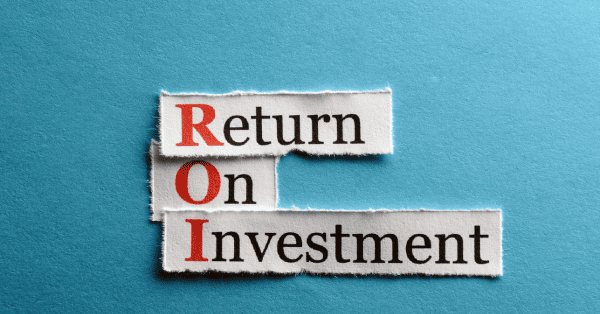Jessica, President and CEO of SW Marketing and Consulting. Graduated from the University of Phoenix with a Bachelor of Science in Business Marketing and a master of Business Administration. Fluent in English, Spanish, French and Portuguese, has paved ways through her career in the Marketing field.
Latest posts by Jessica Jordan (see all)
- Facebook Ads Manager VS Boosted Posts – Difference and Use Cases - March 6, 2024
- What is Subliminal Advertising? - February 22, 2024
- What Type of Google Ads Campaign Fits Your Brand? - February 12, 2024
Marketing ROI measurement is crucial since it sheds light on how effective your marketing is. It identifies (with actual numbers) each campaign’s level of performance and arms you with information to guide your marketing efforts in the right direction.
Marketing quantifies ROI in order to demonstrate how marketing initiatives and campaigns bring in money for the company. Return on investment is referred to by the acronym ROI. And in this situation, it involves comparing the amount of money your business spends on marketing initiatives to the revenue such campaigns produce.
In this article, we’ll talk about ROI, explain the formula, and discuss how crucial it is to define ROI for marketing campaigns. Then we will give advice and techniques to increase ROI.
 ROI means Return on Investment. It calculates the profit an investment generates in relation to its costs. It is utilized as part of analytics and acts as a standard for developing future marketing plans. This makes it possible for you to ascertain which marketing strategies are effective and which ones might be enhanced. In order to calculate the return on investment (ROI), subtract the investment’s initial cost from its final value, divide the result by the cost of the investment, and finally multiply the result by 100.
ROI is important to marketing simply because organizations can assess the contribution of marketing activities to revenue growth either globally or specifically for each campaign by calculating the return on marketing investment. Budget allocation for ongoing and forthcoming campaigns and initiatives, as well as marketing spending, are frequently supported by marketing ROI.
ROI means Return on Investment. It calculates the profit an investment generates in relation to its costs. It is utilized as part of analytics and acts as a standard for developing future marketing plans. This makes it possible for you to ascertain which marketing strategies are effective and which ones might be enhanced. In order to calculate the return on investment (ROI), subtract the investment’s initial cost from its final value, divide the result by the cost of the investment, and finally multiply the result by 100.
ROI is important to marketing simply because organizations can assess the contribution of marketing activities to revenue growth either globally or specifically for each campaign by calculating the return on marketing investment. Budget allocation for ongoing and forthcoming campaigns and initiatives, as well as marketing spending, are frequently supported by marketing ROI.
 Marketers only conduct business for this reason, so it must be. They seek “return,” which you would refer to as financial gain, from their enterprise. But how can you actually determine whether you’re getting paid in return? So there’s no need to muddle your brain. To determine if you are genuinely making a profit or a loss, you just need to understand how to calculate Return on Investment (ROI).
The various methods used to calculate the return on investment are listed below.
Marketers only conduct business for this reason, so it must be. They seek “return,” which you would refer to as financial gain, from their enterprise. But how can you actually determine whether you’re getting paid in return? So there’s no need to muddle your brain. To determine if you are genuinely making a profit or a loss, you just need to understand how to calculate Return on Investment (ROI).
The various methods used to calculate the return on investment are listed below.



 As it gives you information about how efficient your marketing is, measuring marketing ROI is crucial. It identifies (with actual numbers) each campaign’s degree of success and arms you with information that will enable you to guide your marketing efforts in the right direction. Your responsibility to drive the business toward growth and avoid wasting even a single dollar increases when you are aware of your marketing ROI.
Knowing ROI is essential for practically all business choices, whether you’re the CEO, the marketing director, or the firm owner. If you’re unsure of whether your efforts are having an effect, how can you successfully optimize revenue? The value of ROI must be understood by any company that wishes to succeed.
SW Marketing and Consulting can help you achieve ROI as soon as possible. Knowing the in’s and out’s of different marketing platforms enables us to avoid the pitfalls that cost time and money.
As it gives you information about how efficient your marketing is, measuring marketing ROI is crucial. It identifies (with actual numbers) each campaign’s degree of success and arms you with information that will enable you to guide your marketing efforts in the right direction. Your responsibility to drive the business toward growth and avoid wasting even a single dollar increases when you are aware of your marketing ROI.
Knowing ROI is essential for practically all business choices, whether you’re the CEO, the marketing director, or the firm owner. If you’re unsure of whether your efforts are having an effect, how can you successfully optimize revenue? The value of ROI must be understood by any company that wishes to succeed.
SW Marketing and Consulting can help you achieve ROI as soon as possible. Knowing the in’s and out’s of different marketing platforms enables us to avoid the pitfalls that cost time and money.
What is ROI?
 ROI means Return on Investment. It calculates the profit an investment generates in relation to its costs. It is utilized as part of analytics and acts as a standard for developing future marketing plans. This makes it possible for you to ascertain which marketing strategies are effective and which ones might be enhanced. In order to calculate the return on investment (ROI), subtract the investment’s initial cost from its final value, divide the result by the cost of the investment, and finally multiply the result by 100.
ROI is important to marketing simply because organizations can assess the contribution of marketing activities to revenue growth either globally or specifically for each campaign by calculating the return on marketing investment. Budget allocation for ongoing and forthcoming campaigns and initiatives, as well as marketing spending, are frequently supported by marketing ROI.
ROI means Return on Investment. It calculates the profit an investment generates in relation to its costs. It is utilized as part of analytics and acts as a standard for developing future marketing plans. This makes it possible for you to ascertain which marketing strategies are effective and which ones might be enhanced. In order to calculate the return on investment (ROI), subtract the investment’s initial cost from its final value, divide the result by the cost of the investment, and finally multiply the result by 100.
ROI is important to marketing simply because organizations can assess the contribution of marketing activities to revenue growth either globally or specifically for each campaign by calculating the return on marketing investment. Budget allocation for ongoing and forthcoming campaigns and initiatives, as well as marketing spending, are frequently supported by marketing ROI.
Measuring ROI
 Marketers only conduct business for this reason, so it must be. They seek “return,” which you would refer to as financial gain, from their enterprise. But how can you actually determine whether you’re getting paid in return? So there’s no need to muddle your brain. To determine if you are genuinely making a profit or a loss, you just need to understand how to calculate Return on Investment (ROI).
The various methods used to calculate the return on investment are listed below.
Marketers only conduct business for this reason, so it must be. They seek “return,” which you would refer to as financial gain, from their enterprise. But how can you actually determine whether you’re getting paid in return? So there’s no need to muddle your brain. To determine if you are genuinely making a profit or a loss, you just need to understand how to calculate Return on Investment (ROI).
The various methods used to calculate the return on investment are listed below.
- Absolute Return. Absolute Return is the first method used to calculate ROI. Absolute return is determined by comparing the final value of an investment to the price at which it was purchased. Growth through time is calculated in this way. For instance, let’s imagine that five years ago, you put $1,000 into a fund. You made money if the value of your investments today is $2000.
- Price Return. The price return is another metric to assess ROI. In essence, it relates to the variation between the investment’s starting value and end value. It does not take into account dividend payments or interest income when analyzing a specific investment portfolio; only capital gains are taken into account.
- Annualized Return. The yearly average sum of money earned by an investment over a certain period of time is known as the annualized total return. The annualized return formula computes the geometric average of the yearly return to determine how much an investment would make over time if the annual return was compounded.
- Compound Annual Growth Rate. The compound annual growth rate (CAGR), which is based on the assumption that growth occurs at an exponentially compounded pace, is the yearly average rate of revenue increase between two specific years. It is frequently employed to assess and contrast the prior performance of assets or to forecast their anticipated future returns.
- Total Returns. Total return, also known as capital appreciation or depreciation, is the sum of all returns that an investment has generated, including dividends, interest, asset appreciation or depreciation, and capital gains or losses. It is a tool to assess the overall efficiency of an investment over time.
How to Determine Return on Investment for Different Marketing Channels

Social Media
Getting your data and matching it to your objectives is a necessary step in determining your social media ROI. Various social media ROI measures, including impressions, engagements, and link hits, must be considered. Then, to understand your ROI, contrast this data with the expense of executing your campaign. You may calculate the social media ROI for each campaign using the formula below after taking all of your costs into account. ROI for social media: (Earnings – Costs) x 100 / Costs As an example, you spent $500 on Facebook advertising and made $2,000 in sales. Your profit is $1,500 in this case (revenue minus investment = profit), and your social media marketing ROI is computed as follows: $1,500 profit / $500 investment x 100 = 300%. An ROI of 300% is quite impressive!Email Marketing
An email marketing campaign’s ROI measures how cost-effective it is. ROI is defined as (Total income from email – Total email costs) / Total email costs. For instance, you would make $90,000 profit if your revenue was $100,000 and your expenses were $10,000. You gain $9 when you divide it by the $10,000 in costs, or a 900% return on investment.Digital Advertising
Digital advertising ROI is calculated as follows: ROI = (Revenue – Cost of Goods Sold) / Cost of Goods Sold. Take the revenue from your ads and listings, deduct your overall costs, and then divide by your overall costs. Consider the case when your product has a $100 production cost but a $200 retail price. As a result of your Google Ads promotion, you sold six of these products. Your overall revenue is $1200, and your Google Ads expenses are $200. ($1200-($600+$200))/($600+$200), or 50%, is your return on investment.Factors that Affect ROI

- Budget. Your budget allows you to direct funds toward marketing initiatives that have the best return on investment (ROI) and connect marketing techniques with your company’s goals.
- Competition. A company’s market share and customer base shrink in a competitive market, especially if there is a limited amount of demand. A market can also force price reductions in order to stay competitive, which lowers profit margins for any good or service. An extreme case is a market that is overcrowded.
- Timing. Timing is everything when it comes to maximizing revenue and gaining a competitive edge for organizations. Businesses can enhance sales and stay ahead of the competition by timing the debut of a product to take advantage of market conditions, consumer trends, and seasonal demand.
- Industry. In an industry, increased sales and income, as well as higher prices, are two ways to boost your return on investment. Your return will be improved if you can raise sales and revenues while keeping costs the same or just raise costs enough to maintain net profit growth.
Tips for Improving ROI

Here are our top recommendations for taking the appropriate action right away if you want to boost your ROI across all marketing levels.
- Increase Your ROI Using Landing Page Optimization. The goal of landing page optimization, which is a subset of conversion rate optimization, is to boost conversions for a website. It involves rewriting and rearranging different page parts on your landing pages to increase the proportion of website visitors that convert to actual buyers. The ROI rises in direct proportion to conversion rates. You increase the effectiveness of your online marketing initiatives while reducing the cost of consumer acquisition.
- Follow the appropriate metrics. You must have a clear understanding of your objectives and how you intend to assess their achievement before launching any campaign. Choosing the appropriate metrics is so essential. Make sure your metrics are accurate, quantitative, and connected to your main objective to ensure you’re tracking the proper outcomes.
- Make the most of your materials. Making your content work harder will increase its return, as producing quality content requires a significant investment. With a divisible content approach, you can quickly split up a huge piece of content into several pieces or pool several smaller assets to create a single, high-quality piece of content.
- Investigate the opposition. Without having to do the work yourself, you want to know what works. Observe what your rivals are doing. What style are their advertisements? Which messages do they employ? Which pages are ranking higher than you? Which periodicals are using their content? What distribution plan do they have? What subjects are they discussing? You can use these responses to judge what you should and shouldn’t be doing.
Conclusion
 As it gives you information about how efficient your marketing is, measuring marketing ROI is crucial. It identifies (with actual numbers) each campaign’s degree of success and arms you with information that will enable you to guide your marketing efforts in the right direction. Your responsibility to drive the business toward growth and avoid wasting even a single dollar increases when you are aware of your marketing ROI.
Knowing ROI is essential for practically all business choices, whether you’re the CEO, the marketing director, or the firm owner. If you’re unsure of whether your efforts are having an effect, how can you successfully optimize revenue? The value of ROI must be understood by any company that wishes to succeed.
SW Marketing and Consulting can help you achieve ROI as soon as possible. Knowing the in’s and out’s of different marketing platforms enables us to avoid the pitfalls that cost time and money.
As it gives you information about how efficient your marketing is, measuring marketing ROI is crucial. It identifies (with actual numbers) each campaign’s degree of success and arms you with information that will enable you to guide your marketing efforts in the right direction. Your responsibility to drive the business toward growth and avoid wasting even a single dollar increases when you are aware of your marketing ROI.
Knowing ROI is essential for practically all business choices, whether you’re the CEO, the marketing director, or the firm owner. If you’re unsure of whether your efforts are having an effect, how can you successfully optimize revenue? The value of ROI must be understood by any company that wishes to succeed.
SW Marketing and Consulting can help you achieve ROI as soon as possible. Knowing the in’s and out’s of different marketing platforms enables us to avoid the pitfalls that cost time and money. 